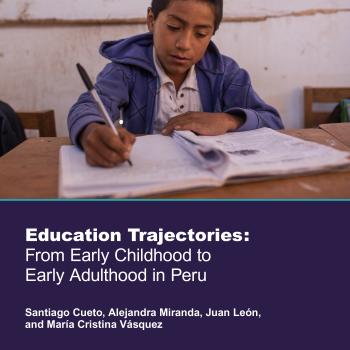
Over the past few decades, every President in Peru has proclaimed education as a priority; yet, in spite of recent progress across several indicators, educational outcomes are still on average low, and gaps between students large and closely linked with their individual and family background. This working paper looks at the education trajectories of children in different stages of life, using data from Young Lives. According to the Peruvian Constitution and General Education Law, education is considered a human right, and all students should have access to a quality service. However, results from this study and others suggest that while there have been important advances over the past two decades, there is still a long way to go for this to become a reality for everyone.
Progress in enrolment and average achievement is clear in the educational trajectories of the two cohorts of children from early childhood to adulthood. This reflects the importance the population and successive governments have attributed to education. However, large disparities remain, related to students´ and family’s characteristics. In basic education, inequality is not related so much to access to school as it is to the educational opportunities children have at school, and their results in standardised tests. Children who come from relatively poor families, are indigenous, have a mother with less than complete secondary education, or who live in a rural family tend to have fewer opportunities and lower outcomes than their peers; the situation is worse for those who combine several of these family characteristics. Fortunately, disparities in opportunities and achievement by sex are relatively small. In tertiary education, there are still large gaps in access between groups, with privileged students having more access to university studies.
The paper concludes that the educational system may be reinforcing inequalities since it does not provide equal opportunities for all children; ideally, it should prioritise the opportunities of children and young adults who we know are more likely to have poor educational outcomes (i.e. vulnerable children). This should start at a young age, as gaps in achievement are evident by age 5. There are reasons to be optimistic, however, as public funding in education is increasing rapidly. In this scenario, inequality in educational opportunities and outcomes becomes a priority.

Over the past few decades, every President in Peru has proclaimed education as a priority; yet, in spite of recent progress across several indicators, educational outcomes are still on average low, and gaps between students large and closely linked with their individual and family background. This working paper looks at the education trajectories of children in different stages of life, using data from Young Lives. According to the Peruvian Constitution and General Education Law, education is considered a human right, and all students should have access to a quality service. However, results from this study and others suggest that while there have been important advances over the past two decades, there is still a long way to go for this to become a reality for everyone.
Progress in enrolment and average achievement is clear in the educational trajectories of the two cohorts of children from early childhood to adulthood. This reflects the importance the population and successive governments have attributed to education. However, large disparities remain, related to students´ and family’s characteristics. In basic education, inequality is not related so much to access to school as it is to the educational opportunities children have at school, and their results in standardised tests. Children who come from relatively poor families, are indigenous, have a mother with less than complete secondary education, or who live in a rural family tend to have fewer opportunities and lower outcomes than their peers; the situation is worse for those who combine several of these family characteristics. Fortunately, disparities in opportunities and achievement by sex are relatively small. In tertiary education, there are still large gaps in access between groups, with privileged students having more access to university studies.
The paper concludes that the educational system may be reinforcing inequalities since it does not provide equal opportunities for all children; ideally, it should prioritise the opportunities of children and young adults who we know are more likely to have poor educational outcomes (i.e. vulnerable children). This should start at a young age, as gaps in achievement are evident by age 5. There are reasons to be optimistic, however, as public funding in education is increasing rapidly. In this scenario, inequality in educational opportunities and outcomes becomes a priority.

